Impact of Digestate-Derived Nitrogen on Nutrient Content Dynamics in Winter Oilseed Rape Before Flowering
Abstract
1. Introduction
2. Materials and Methods
2.1. Site Description
2.2. Experimental Design
2.3. Chemical Analysis and Indices
2.4. Criteria for Assessment of WOSR Nutritional Status at Cardinal Stages of Growth
2.5. Statistical Analyses
3. Results
3.1. Seed Yield of Winter Oilseed Rape
3.2. WOSR Nutritional Status—Rosettes
3.3. WOSR Nutritional Status—Leaves
3.4. WOSR Nutritional Status—Stems
4. Discussion
- (1)
- Formal, based on a statistical comparison of three fertilization systems (FSs), differing in the N carrier;
- (2)
- Formal, based on existing ranges of nutrient contents in indicator parts/organs of the tested crop;
- (3)
- Forecast of the crop biomass and seed yield based on nutrient content in respective parts/organs of the tested crop before flowering.
4.1. Seed Yield of Winter Oilseed Rape
4.2. WOSR Nutritional Status—Rosette Stage
4.3. The Beginning of Flowering—Leaves as Diagnostic Plant Parts
4.4. The Beginning of Flowering—Stems as Diagnostic Plant Parts
5. Conclusions
Supplementary Materials
Author Contributions
Funding
Data Availability Statement
Conflicts of Interest
Abbreviations
| AN | Ammonium nitrate |
| CV | Coefficient of variation |
| BBCH 30 | Rosette stage of WOSR growth |
| BBCH 60 | The beginning of WOSR flowering |
| BR | Biomass of rosette leaves |
| BL | Biomass of WOSR leaves at the beginning of flowering |
| BS | Biomass WOSR stems at the beginning of flowering |
| DM | Dry matter |
| FS | Fertilization system |
| M-FS | Mineral-ammonium nitrate FS |
| O-FS | Organic-digestate FS |
| OM-FS | Mixed: organic-mineral FS |
| Nf | Nitrogen fertilizer |
| NFRV | Nitrogen fertilizer replacement value |
| NG | Nitrogen gap |
| SY | Seed yield |
| WOSR | Winter oilseed rape |
| YG | Yield gap |
Appendix A
| Variables | P | K | Mg | Ca | Fe | Mn | Zn | Cu | BR | SY |
|---|---|---|---|---|---|---|---|---|---|---|
| N | −0.12 | 0.62 *** | −0.37 * | 0.01 | 0.09 | 0.32 * | 0.66 *** | 0.46 ** | −0.36 * | −0.10 |
| P | 1.00 | 0.32 * | 0.59 *** | −0.23 | −0.80 *** | −0.48 ** | −0.20 | −0.01 | 0.74 *** | 0.10 |
| K | 1.00 | −0.29 | 0.10 | −0.41 ** | 0.17 | 0.71 *** | 0.57 *** | −0.03 | −0.41 ** | |
| Mg | 1.00 | −0.13 | −0.43 ** | −0.66 *** | −0.70 *** | −0.52 *** | 0.81 *** | 0.57 *** | ||
| Ca | 1.00 | 0.01 | −0.01 | 0.28 | 0.05 | −0.14 | −0.45 ** | |||
| Fe | 1.00 | 0.36 * | 0.06 | 0.01 | −0.58 *** | 0.16 | ||||
| Mn | 1.00 | 0.47 ** | 0.68 *** | −0.58 *** | −0.25 | |||||
| Zn | 1.00 | 0.66 *** | −0.61 *** | −0.60 *** | ||||||
| Cu | 1.00 | −0.31 * | −0.42 ** | |||||||
| BR | 1.00 | 0.46 ** |
| Variables | P | K | Mg | Ca | Fe | Mn | Zn | Cu | SY | BL | BS | BC |
|---|---|---|---|---|---|---|---|---|---|---|---|---|
| N | 0.14 | 0.21 | 0.07 | 0.31 * | −0.12 | 0.27 | 0.51 *** | 0.12 | 0.28 | 0.03 | −0.02 | −0.01 |
| P | 1.00 | −0.69 *** | −0.68 *** | −0.02 | 0.68 *** | 0.66 *** | 0.39 ** | 0.82 ** | −0.03 | −0.10 | −0.63 *** | −0.51 *** |
| K | 1.00 | 0.55 *** | 0.23 | −0.71 *** | −0.36 *** | 0.09 | −0.74 *** | 0.08 | 0.09 | 0.59 *** | 0.47 ** | |
| Mg | 1.00 | −0.41 ** | −0.36 * | −0.52 *** | −0.60 *** | −0.52 *** | 0.52 *** | 0.48 ** | 0.85 *** | 0.79 *** | ||
| Ca | 1.00 | −0.34 ** | 0.08 | 0.69 *** | −0.13 | −0.58 *** | −0.44 ** | −0.37 * | −0.42 ** | |||
| Fe | 1.00 | 0.46 ** | −0.03 | 0.72 *** | 0.16 | 0.03 | −0.36 * | −0.27 | ||||
| Mn | 1.00 | 0.47 ** | 0.60 *** | 0.05 | 0.08 | −0.37 * | −0.25 | |||||
| Zn | 1.00 | 0.21 | −0.39 ** | −0.42 ** | −0.54 *** | −0.54 ** | ||||||
| Cu | 1.00 | 0.16 | 0.07 | −0.44 ** | −0.31 * | |||||||
| SY | 1.00 | 0.74 *** | 0.64 *** | 0.71 *** | ||||||||
| BL | 1.00 | 0.72 *** | 0.85 *** | |||||||||
| BS | 1.00 | 0.98 *** |
| Variables | P | K | Mg | Ca | Fe | Mn | Zn | Cu | SY | BL | BS | BC |
|---|---|---|---|---|---|---|---|---|---|---|---|---|
| N | 0.27 | 0.59 *** | −0.33 * | 0.68 *** | −0.27 | −0.33 * | 0.76 *** | 0.28 | −0.09 | −0.28 | −0.27 | −0.29 |
| P | 1.00 | −0.39 ** | −0.88 *** | 0.24 | −0.89 *** | −0.89 *** | 0.64 *** | 0.66 *** | −0.31 * | −0.31 * | −0.78 *** | −0.69 *** |
| K | 1.00 | 0.26 | 0.37 * | 0.33 * | 0.32 * | 0.32 * | −0.18 | 0.21 | 0.10 | 0.40 ** | 0.33 * | |
| Mg | 1.00 | −0.35 * | 0.89 *** | 0.90 *** | −0.73 *** | −0.69 *** | 0.37 * | 0.31 * | 0.78 *** | 0.69 *** | ||
| Ca | 1.00 | −0.29 | −0.33 * | 0.64 *** | 0.06 | −0.58 *** | −0.46 ** | −0.40 ** | −0.44 ** | |||
| Fe | 1.00 | 0.95 *** | −0.62 *** | −0.67 *** | 0.23 | 0.20 | 0.71 *** | 0.59 *** | ||||
| Mn | 1.00 | −0.67 *** | −0.68 *** | 0.32 * | 0.27 | 0.76 *** | 0.65 *** | |||||
| Zn | 1.00 | 0.56 *** | −0.30 * | −0.37 * | −0.57 *** | −0.55 *** | ||||||
| Cu | 1.00 | 0.10 | 0.01 | −0.50 *** | −0.38 * |
Appendix B
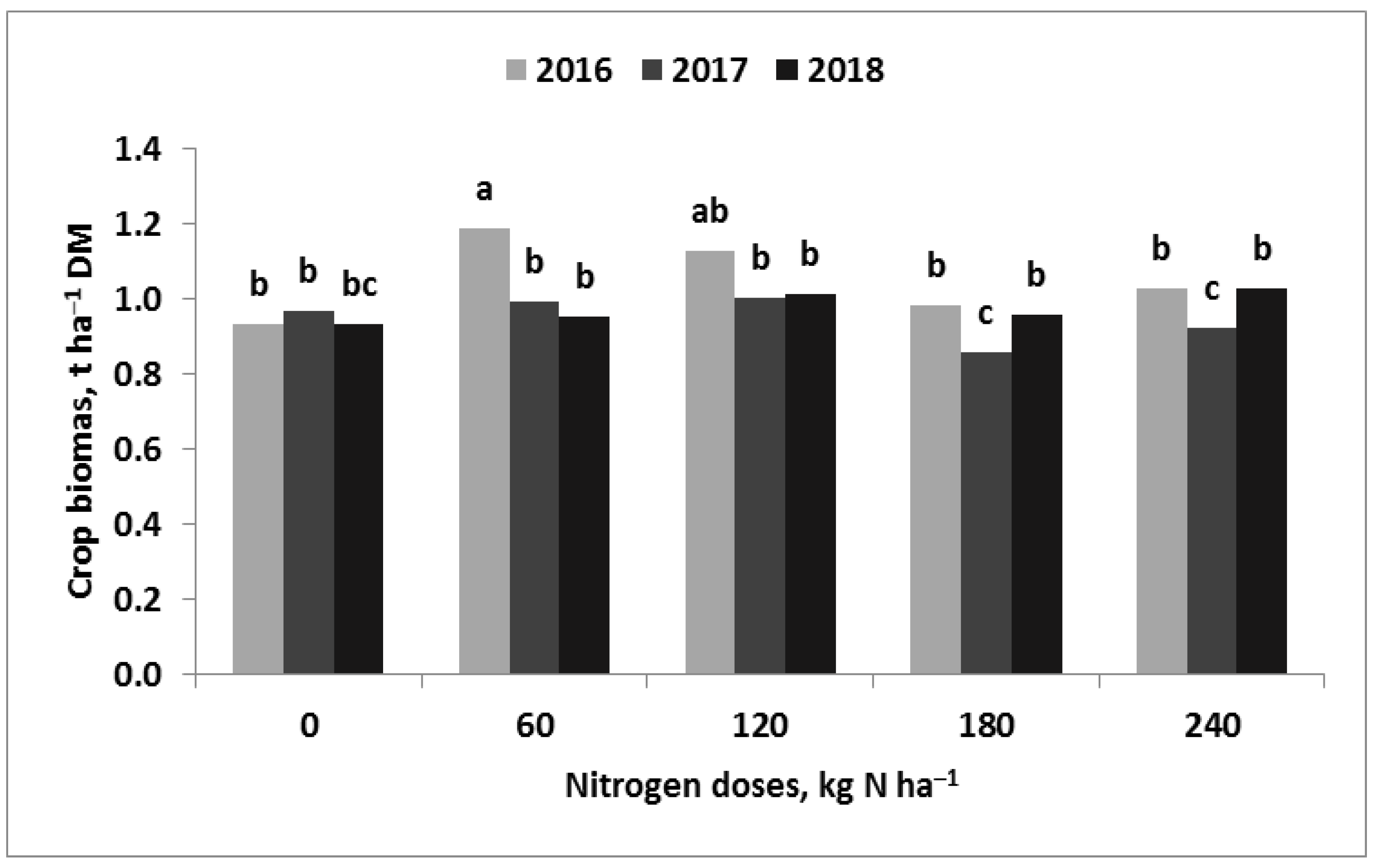
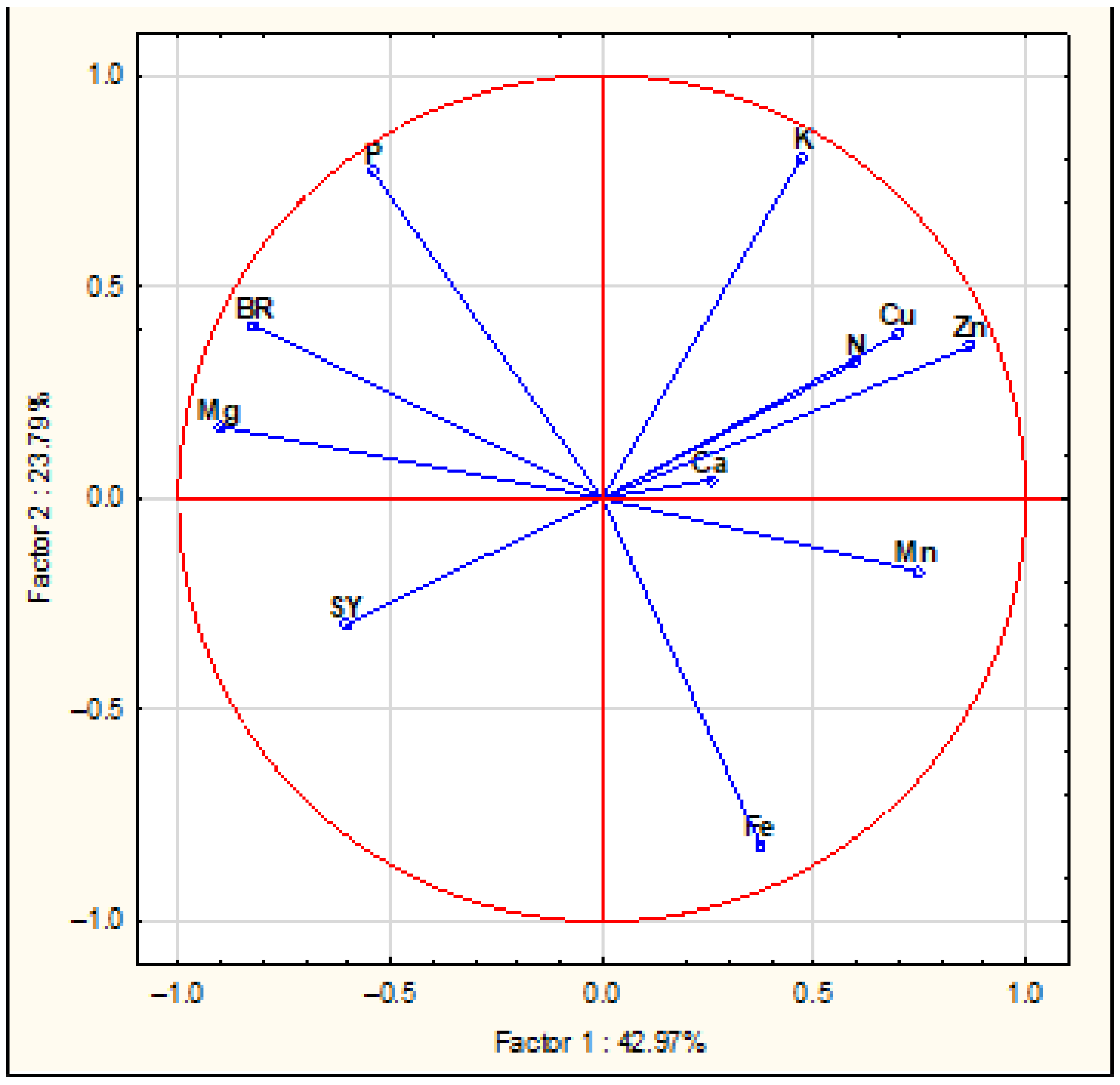
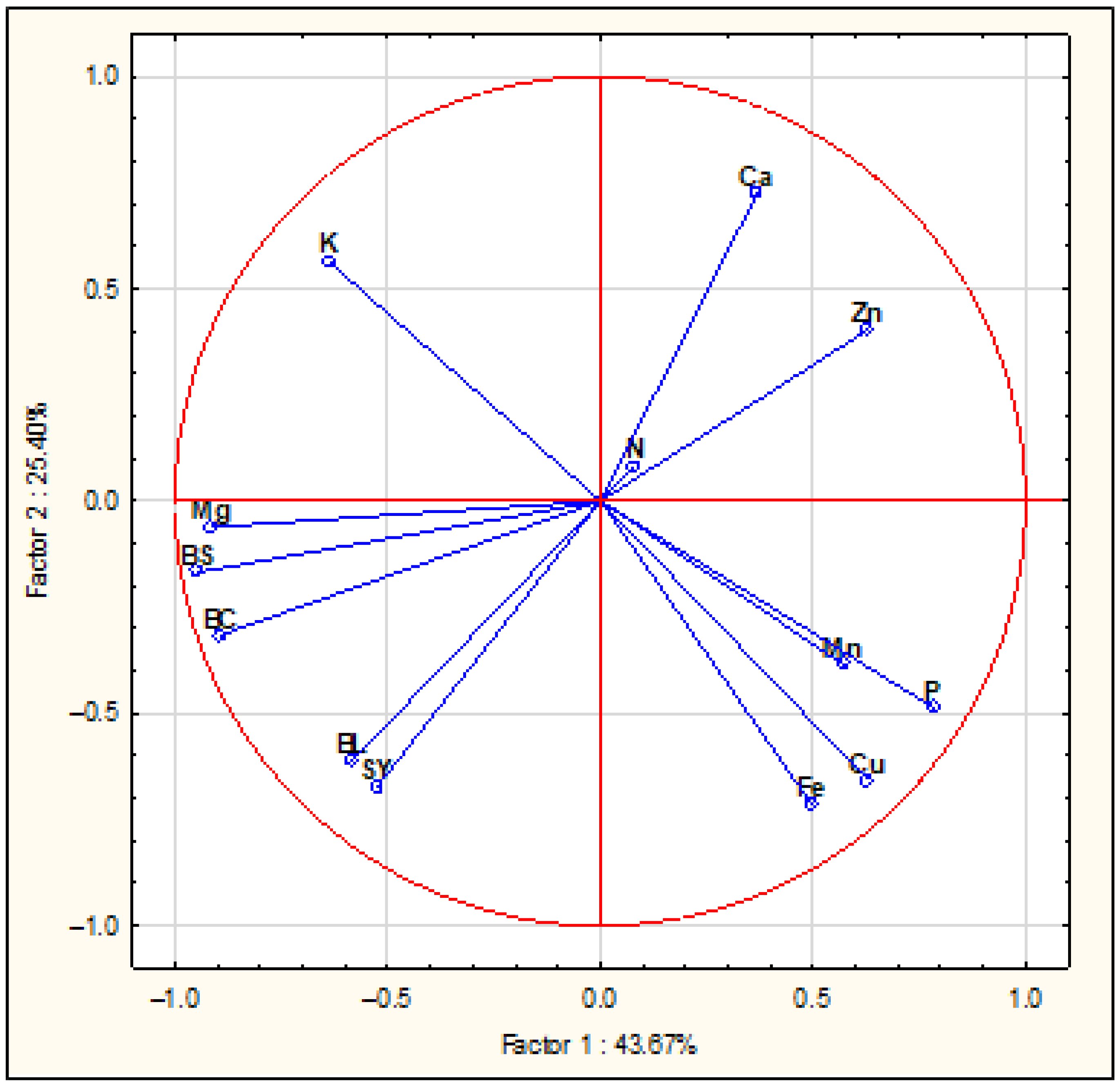



References
- Van Ittersum, M.K.; Cassman, K.G.; Grassini, P.; Wolf, J.; Tittonell, P.; Hochman, Z. Yield gap analysis with local to global relevance—A review. Field Crops Res. 2013, 143, 4–17. [Google Scholar] [CrossRef]
- Licker, R.; Johnston, M.; Foley, J.A.; Barford, C.; Kucharik, C.J.; Monfreda, C.; Ramankutty, N. Mind the gap: How do climate and agricultural management explain the “yield gap” of croplands around the world? Glob. Ecol. Biogeogr. 2010, 19, 769–782. [Google Scholar] [CrossRef]
- Asseng, S.; Guarin, J.R.; Raman, M.; Monje, O.; Kiss, G.; Despomnier, D.D.; Meggers, F.M.; Gaither, P.P.G. Wheat yield potential in controlled–environment vertical farms. Proc. Natl. Acad. Sci. USA 2020, 117, 19131–19135. [Google Scholar] [CrossRef]
- Łukowiak, R.; Grzebisz, W.; Ceglarek, J.; Podolski, A.; Kaźmierowski, C.; Piekarczyk, J. Spatial variability of yield and nitrogen indicators-a crop rotation approach. Agronomy 2020, 10, 1959. [Google Scholar] [CrossRef]
- Barłóg, P.; Grzebisz, W.; Łukowiak, R. Fertilizers and fertilization strategies mitigating soil factors constraining efficiency of nitrogen in plant production. Plants 2022, 11, 1855. [Google Scholar] [CrossRef]
- Grzebisz, W.; Diatta, J.; Barłóg, P.; Biber, M.; Potarzycki, J.; Łukowiak, R.; Przygocka-Cyna, K.; Szczepaniak, W. Soil Fertility Clock—Crop rotation as a paradigm in nitrogen fertilizer productivity control. Plants 2022, 11, 2841. [Google Scholar] [CrossRef]
- Anas, M.; Liao, F.; Verma, K.K.; Sarwar, M.A.; Mahmood, A.; Chen, Z.-L.; Li, Q.; Zeng, X.-P.; Liu, Y.; Li, Y.-R. Fate of nitrogen in agriculture and environment: Agronomic, eco-physiological and molecular approaches to improve nitrogen use efficiency. Biol. Res. 2020, 53, 47. [Google Scholar] [CrossRef]
- Grzebisz, W.; Łukowiak, R. Nitrogen gap amelioration is a core for sustainable intensification of agriculture—A concept. Agronomy 2021, 11, 419. [Google Scholar] [CrossRef]
- Conijn, J.G.; Bindraban, P.S.; Schröder, J.J.; Jongschaap, R.E.E. Can our global food system meet food demand within planetary boundries? Agric. Ecosys. Environ. 2018, 251, 244–256. [Google Scholar] [CrossRef]
- Rockström, J.; Williams, J.; Daily, G.; Noble, A.; Matthews, N.; Gordon, L.; Wetterstrand, H.; DeClerck, F.; Shah, M.; Steduto, P.; et al. Sustainable intensification of agriculture for human prosperity and global sustainability. Ambio 2017, 46, 4–17. [Google Scholar] [CrossRef]
- Sattari, S.Z.; van Ittersum, M.K.; Bouwman, A.F.; Smit, A.L.; Janssen, B.H. Crop yield response to soil fertility and N, P, K inputs in different environments: Testing and improving the QEFTS model. Field Crops Res. 2014, 157, 35–46. [Google Scholar] [CrossRef]
- Pretty, J.; Bharucha, Z.P. Sustainable intensification in agricultural systems. Ann. Bot. 2014, 114, 1571–1596. [Google Scholar] [CrossRef]
- Alburquerque, J.A.; De la Fuente, C.; Ferre-Costa, A.; Carrasco, L.; Cegarra, J.; Abad, M.; Bernal, M.P. Assessment of the fertiliser potential of digestates from farm and agro-industrial residues. Biomass Bioenerg. 2012, 40, 181–189. [Google Scholar] [CrossRef]
- Nkoa, R. Agricultural benefits and environmental risks of soil fertilization with anaerobic digestates: A review. Agron. Sustain. Dev. 2014, 34, 473–492. [Google Scholar] [CrossRef]
- Sogn, T.A.; Dragicevic, I.; Linjordet, R.; Krogstad, T.; Eijsink, V.G.; Eich-Greatorex, S. Recycling of biogass digestates in plant production: NPK fertilizer value and risk of leaching. Int. J. Rec. Org. Wastes Agric. 2018, 7, 49–58. [Google Scholar] [CrossRef]
- Häfner, F.; Hartung, J.; Moller, K. Digestate composition affecting N fertilizer value and C mineralization. Waste Biomass Valirization 2022, 13, 3445–3462. [Google Scholar] [CrossRef]
- Van Midden, C.; Harris, J.; Shaw, L.; Sizmur, T.; Pawlett, M. The impact of anaerobic digestate on soil life; a review. Appl. Soil Ecol. 2023, 191, 105066. [Google Scholar] [CrossRef]
- Barłóg, P.; Hlisnikovský, L.; Kunzová, E. Effect of digestate on soil organic carbon and plant-available nutrient content compared to cattle slurry and mineral fertilization. Agronomy 2020, 10, 379. [Google Scholar] [CrossRef]
- Przygocka-Cyna, K.; Grzebisz, W. The multifactorial effect of digestate on the availability of soil elements and grain yield and its mineral profile—The case of maize. Agronomy 2020, 10, 275. [Google Scholar] [CrossRef]
- Garcia-López, A.M.; Delgado, A.; Anjos, O.; Horta, C. Digestate not only affects nutrient availability but also soil quality indicators. Agronomy 2023, 13, 1308. [Google Scholar] [CrossRef]
- Sieling, K.; Herrmann, A.; Wienforth, B.; Taube, F.; Ohl, S.; Hartung, E.; Kage, H. Biogas cropping systems: Short term response of yield performance and N use efficiency to biogas residue application. Europ. J. Agron. 2013, 47, 44–55. [Google Scholar] [CrossRef]
- De Notaris, C.; Sørensen, P.; Møller, H.B.; Wahid, R.; Eriksen, J. Nitrogen replacement value of digestate from three green manures. Nutr. Cycl. Agroecosyst. 2018, 112, 355–368. [Google Scholar] [CrossRef]
- Doyeni, M.O.; Stulpinaite, U.; Baksinskaite, A.; Supronienie, S.; Tilvikiene, V. The effectiveness of digestate use for fertilization in an agricultural cropping system. Plants 2021, 10, 1734. [Google Scholar] [CrossRef]
- Morris, D.R.; Lathwell, D.J. Anaerobically digested dairy manure as fertilizer for maize in acid and alkaline soils. Comm. Soil. Sci. Plant. Anal. 2004, 11–12, 1757–1771. [Google Scholar] [CrossRef]
- Przygocka-Cyna, K.; Grzebisz, W. Biogas digestate–benefits and risks for soil fertility and crop quality—An evaluation of grain response. Open Chem. 2018, 16, 258–271. [Google Scholar] [CrossRef]
- Baryga, A.; Połeć, B.; Klasa, A. Quality of sugar beets under efefcts of digestate application to the soil. Processes 2020, 8, 1402. [Google Scholar] [CrossRef]
- Pullens, J.W.M.; Sharif, B.; Trnka, M.; Balek, J.; Semenov, M.A.; Olesen, J.E. Risk factors for European winter oilseed rape production under climate change. Agric. For. Meteorol. 2019, 272–273, 30–39. [Google Scholar] [CrossRef]
- Szczepaniak, W.; Barłóg, P.; Łukowiak, R.; Przygocka-Cyna, K. Effect of balanced nitrogen fertilization in four-year rotation on plant productivity. J. Cent. Eur. Agric. 2013, 14, 64–77. [Google Scholar] [CrossRef]
- Szczepaniak, W.; Grzebisz, W.; Barłóg, P.; Przygocka-Cyna, K. Mineral composition of winter oilseed rape (Brassica napus L.) seeds as a tool for oil seed prognosis. J. Cen. Europ. Agric. 2017, 18, 196–213. [Google Scholar] [CrossRef]
- Lu, H.; Lu, J.; Ren, T.; Li, X.; Cong, R. Nutrient efficiency of winter oilseed rape in an intensive cropping system: A regional analysis. Podosphere 2017, 27, 364–370. [Google Scholar]
- Weymann, W.; Bottcher, U.; Sieling, K.; Kage, H. Effects of weather conditions during different growth phases on yield formation of winter oilseed rape. Field Crop. Res. 2015, 173, 41–48. [Google Scholar] [CrossRef]
- Barłóg, P.; Grzebisz, W. Effect of timing and nitrogen fertilizer application on winter oilseed rape (Brassica napus L.). I. Growth dynamics and seed yield. J. Agron. Crop Sci. 2004, 190, 305–313. [Google Scholar] [CrossRef]
- Barłóg, P.; Grzebisz, W. Effect of timing and nitrogen fertilizer application on winter oilseed rape (Brassica napus L.). II. Nitrogen uptake dynamics and fertilizer efficiency. J. Agron. Crop Sci. 2004, 190, 314–323. [Google Scholar] [CrossRef]
- Grzebisz, W.; Łukowiak, R.; Kotnis, K. Evaluation of nitrogen fertilization systems based on the in-season variability of nitrogenous growth factors and soil fertility factors: A case of winter oilseed rape (Brassica napus L.). Agronomy 2020, 10, 1701. [Google Scholar] [CrossRef]
- Szczepaniak, W. The mineral profile of winter oilseed rape in critical growth stages–potassium. J. Elem. 2014, 19, 203–215. [Google Scholar] [CrossRef]
- Mehlich, A. Mehlich 3 soil test extractant: A modification of Mehlich 2 extractant. Commun. Soil Sci. Plant Anal. 1984, 15, 1409–1416. [Google Scholar] [CrossRef]
- Kęsik, K. Application of the Mehlich 3 method in the fertilizer advisory system. Stud. I Rap. IUNG-PIB 2016, 48, 95–104. (In Polish) [Google Scholar]
- Trávník, K.; Zbíral, J.; Němec, P. Agrochemical Soil Testing—Mehlich III; Central Institute for Supervising and Testing in Agriculture: Brno, Czech, 1999. (In Czech) [Google Scholar]
- Zbíral, J. Determination of plant-available micronutrients by the Mehlich 3 soil extractant—A proposal of critical values. Plant Soil Environ. 2016, 62, 527–531. [Google Scholar] [CrossRef]
- Fotyma, E.; Fotyma, M.; Pietruch, C. The content of mineral N in arable soils in Poland. Fertil. Fertil. 2004, 3, 11–54. [Google Scholar]
- Grzebisz, W.; Przygocka-Cyna, K.; Szczepaniak, W.; Zawieja, A. Impact of winter oilseed rape nutritional status during vegetative growth on yield. Plant, Soil Environ. 2019, 65, 490–496. [Google Scholar] [CrossRef]
- Merrien, A. Winter oilseed rape–example Europe. In IFA World Fertilizer Use Manual; International Industry Association: Paris, France, 1992; pp. 215–219. [Google Scholar]
- Weichmann, W. World Fertilizer Use Manual; IFA: Riverton, UT, USA, 1992; 600p, Available online: http://www.fertilizer.org/ifa/home-page/Library/our-selectionw/2World-Fertilizer-Use-manual (accessed on 20 February 2025).
- Grzebisz, W. Part I. Oil crops, root and tuber crops, legumes. In Technology of Crop Plant Fertilization—Yielding Physiology; PWRiL: Poznań, Poland, 2009; p. 414. (In Polish) [Google Scholar]
- Bergmann, W. Nutritional Disorders of Plants; Verlag Gustav Fisher: Jena, Germany, 1992; 741p. [Google Scholar]
- Orlovius, K. Fertilizing for High Yield and Quality. Oilseed Rape; International Potash Institute Bulletin: Base, Switzerland, 1992; 130p. [Google Scholar]
- Barłóg, P.; Grzebisz, W.; Diatta, J. Effect of timing and nitrogen fertilizers on nutrients content and uptake of winter oilseed rape. Part I. Dry matter accumulation and nutrients content. In Chemistry for Agriculture; Górecki, H., Dobrzański, Z., Kafarski, P., Eds.; Czech-Pol Trade: Prague, Czech Republic, 2005; Volume 6, pp. 102–112. [Google Scholar]
- Wilding, L.P.; Dress, L.R. Spatial variability and pedology. In Pedogenesis and Soil Taxonomy; Wilding, L.P., Smeck, N., Hall, G.F., Eds.; Elsevier Science: Wageningen, The Netherlands, 1983; pp. 83–116. [Google Scholar]
- Smith, G. Step away from stepwise. J. Big Data 2018, 5, 32. [Google Scholar] [CrossRef]
- Bouchet, A.S.; Laperche, A.; Bissuel-Belaygue, C.; Snowdon, R.; Nesi, N.; Stahl, A. Nitrogen use efficiency in rapeseed. A review. Agron. Sustain. Dev. 2016, 36, 38. [Google Scholar] [CrossRef]
- Rathke, G.W.; Behrens, T.; Diepenbrock, W. Integrated nitrogen management strategies to improve seed yield, oil content and nitrogen efficiency of winter oilseed rape (Brassica napus L.): A review. Agric. Ecosyst. Environ. 2016, 117, 80–108. [Google Scholar] [CrossRef]
- Zając, T.; Klimek-Kopyra, A.; Oleksy, A.; Lorenc-Kozik, A.; Ratajczak, K. Analysis of yield and plant traits of oilseed rape (Brassica napus L.) cultivated in temperate region in light of the possibilities of sowing in arid areas. Acta Agrobot. 2016, 69, 1696. [Google Scholar] [CrossRef]
- Rutkowska, A. Productivity of winter oilseed rape depending on its nitrogen and water use efficiency. Polish J. Agron. 2019, 39, 39. [Google Scholar]
- Grzebisz, W.; Szczepaniak, W.; Grześ, S. Sources of nutrients for high-yielding winter oilseed rape (Brassica napus L.) during post-flowering growth. Agronomy 2020, 10, 626. [Google Scholar] [CrossRef]
- Łukowiak, R.; Grzebisz, W. Effect of site specific nitrogen management on seed nitrogen—A driving factor of winter oilseed rape (Brassica napus L.) yield. Agronomy 2020, 10, 1364. [Google Scholar] [CrossRef]
- Möller, K.; Stinner, W. Effects of different manuring systems with and without biogas digestion on soil mineral nitrogen content and on gaseous nitrogen losses (ammonia, nitrous oxides). Eur. J. Agron. 2009, 30, 1–16. [Google Scholar] [CrossRef]
- Malagoli, M.; Laine, P.; Rossato, L.; Ourry, A. Dynamics of nitrogen uptake and mobilization in field-grown winter oilseed rape (Brassica napus L.) from stem extension to harvest. I. Global N flows between vegetative and reproductive tissues in relations to leaf fall and their residual N. Ann. Bot. 2005, 95, 853–861. [Google Scholar] [CrossRef]
- Wang, X.; Mathieu, A.; Cournede, P.H.; Allirand, J.M.; Jullien, A.; de Reffye, P.; Zhang, B.G. Variability and regulation of the number of ovules, seeds, and pods according to assimilate availability in winter oilseed rape (Brassica napus L.). Field Crops Res. 2011, 122, 60–69. [Google Scholar] [CrossRef]
- Sokólski, M.; Jankowski, K.J.; Załuski, D.; Szatkowski, D. productivity, energy and economic balance in the production of different cultivars of winter oilseed rape. A case study in North-Eastern Poland. Agronomy 2020, 10, 508. [Google Scholar] [CrossRef]
- Grzebisz, W.; Barłóg, P.; Kryszak, J.; Łukowiak, R. Pre-anthesis nutritional status of spelt wheat as a tool for predicting the attainable grain yield. Agronomy 2019, 9, 558. [Google Scholar] [CrossRef]
- Grzebisz, W.; Szczepaniak, W.; Przygocka-Cyna, K.; Biber, M.; Spiżewski, T. Sources of nutrients for the growing ear of winter wheat in the Critical Cereal Window. Agronomy 2024, 14, 3018. [Google Scholar] [CrossRef]
- Marschner, H. Mineral Nutrition of Higher Plants, 2nd ed.; Elsevier Ltd.: London, UK, 1995; 899p. [Google Scholar]
- Szczepaniak, W.; Grzebisz, W.; Potarzycki, J.; Łukowiak, R.; Przygocka-Cyna, K. Nutritional status of winter oilseed rape in cardinal stages of growth as yield indicator. Plant Soil Environ. 2015, 61, 291–296. [Google Scholar] [CrossRef]
- Grzebisz, W.; Łukowiak, R.; Biber, M.; Przygocka-Cyna, K. Effect of multi-micronutrient fertilizers applied to foliage on nutritional status of winter oilseed rape and development of yield forming elements. J. Elem. 2010, 15, 477–491. [Google Scholar] [CrossRef][Green Version]
- Thor, K. Calcium–nutrient and messanger. Front Plant Sci. 2019, 10, 440. [Google Scholar] [CrossRef]
- Wang, T.; Chen, X.; Ju, C.; Wang, C. Calcium signalling in plant mineral nutrition: From uptake to transport. Plant Comm. 2023, 4, 100678. [Google Scholar] [CrossRef]
- Szczepaniak, W.; Grzebisz, W.; Potarzycki, J.; Łukowiak, R.; Przygocka-Cyna, K. The magnesium and calcium mineral status of maize at physiological maturity as a tool for an evaluation of yield forming conditions. J. Elem. 2015, 21, 881–897. [Google Scholar] [CrossRef]
- Potarzycki, J.; Grzebisz, W. The in-season variability in the calcium concentration in potato organs and its relationships with the tuber yield. J. Elem. 2020, 25, 107–124. [Google Scholar] [CrossRef]
- ISO 11277; Soil Quality–Determination of Particle Size Distribution in Mineral Soil Material. Method by Sieving and Sedimentation. ISO: Geneva, Switzerland, 2009.
- PTGleb. Particle size distribution and textural classes of soils and mineral materials–classification of Polish Society of Soil Sciences (in Polish). Soil Sci. Ann. 2008, 60, 5–16. [Google Scholar]
- Sumner, M.E.; Miller, W.P. Cation exchange capacity and exchange coefficients. In Methods of Soil Analysis. Part 3—CHEMICAL Methods; Sparks, D.L., Page, A.L., Helmke, P.A., Loeppert, R.H., Soltanpour, P.N., Tabatabai, M.A., Johnston, C.T., Sumner, M.E., Bartels, J.M., Bigham, J.M., Eds.; Soil Science Society of America: Madison, WI, USA, 1996; pp. 1201–1229. [Google Scholar]
- Shuman, L.M.; Duncan, R.R. Soil exchangeable cations and aluminum measured by ammonium chloride, potassium chloride, and ammonium acetate. Comm. Soil Sci. Plant Anal. 1990, 21, 1217–1228. [Google Scholar] [CrossRef]
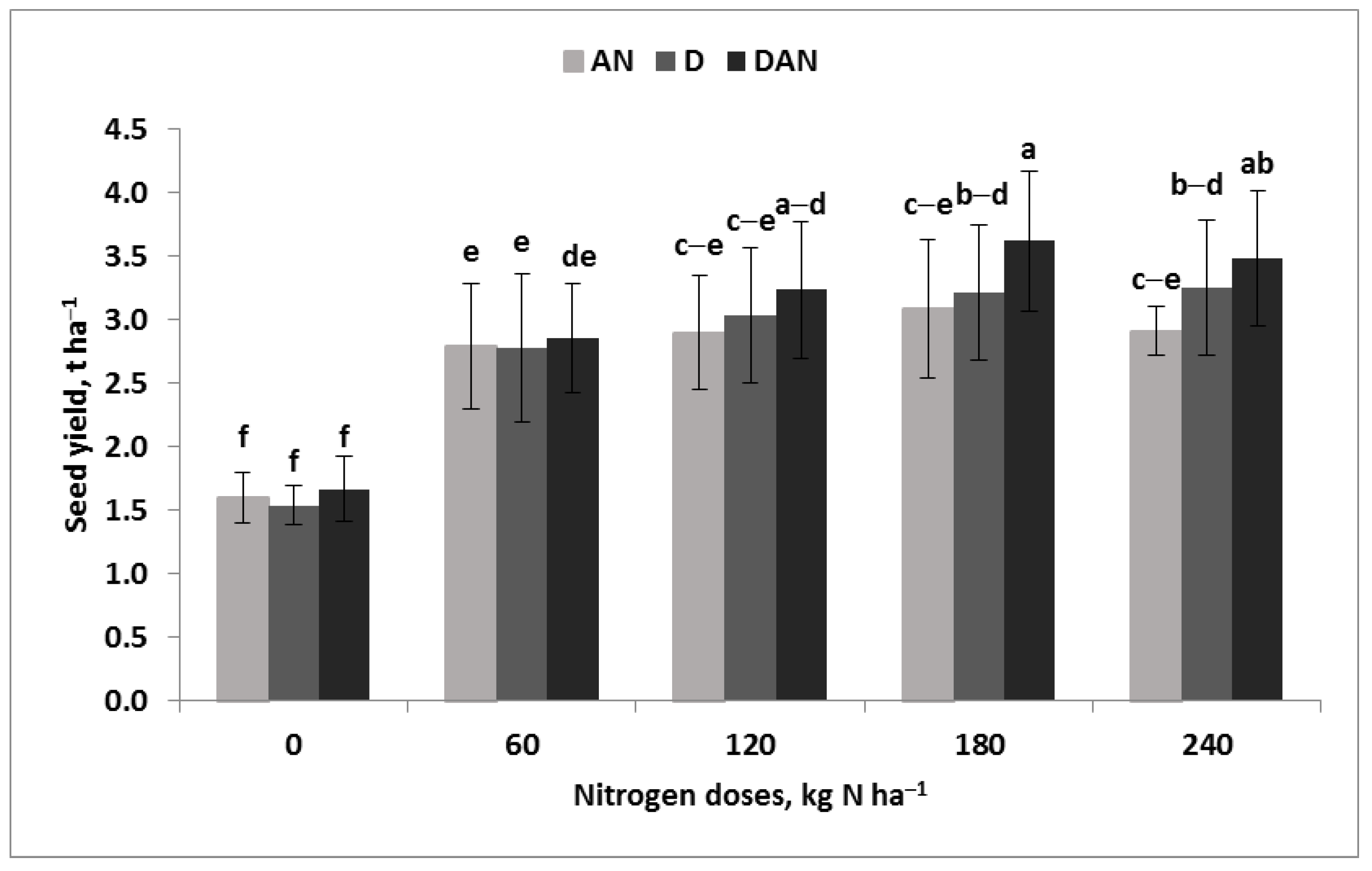

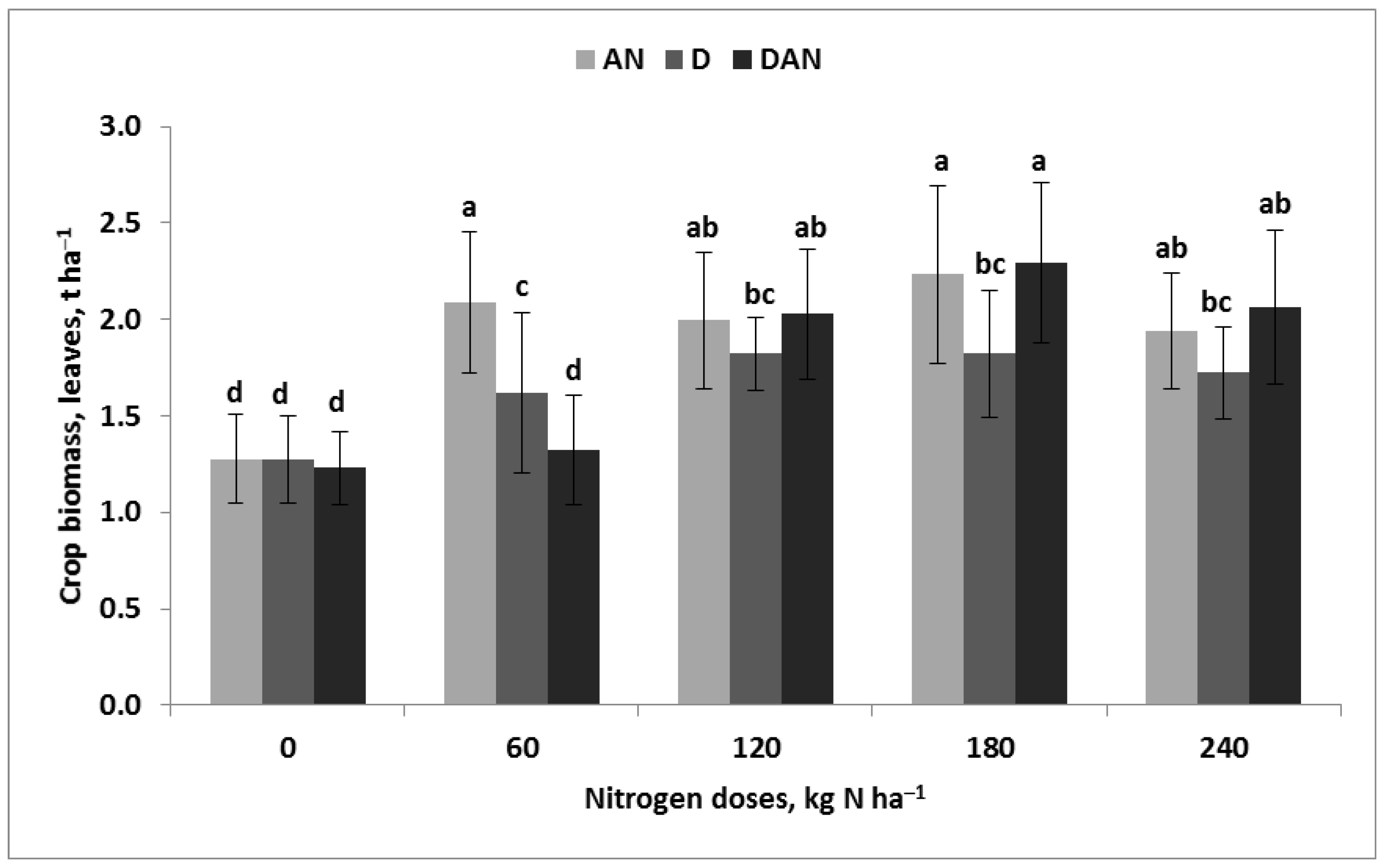

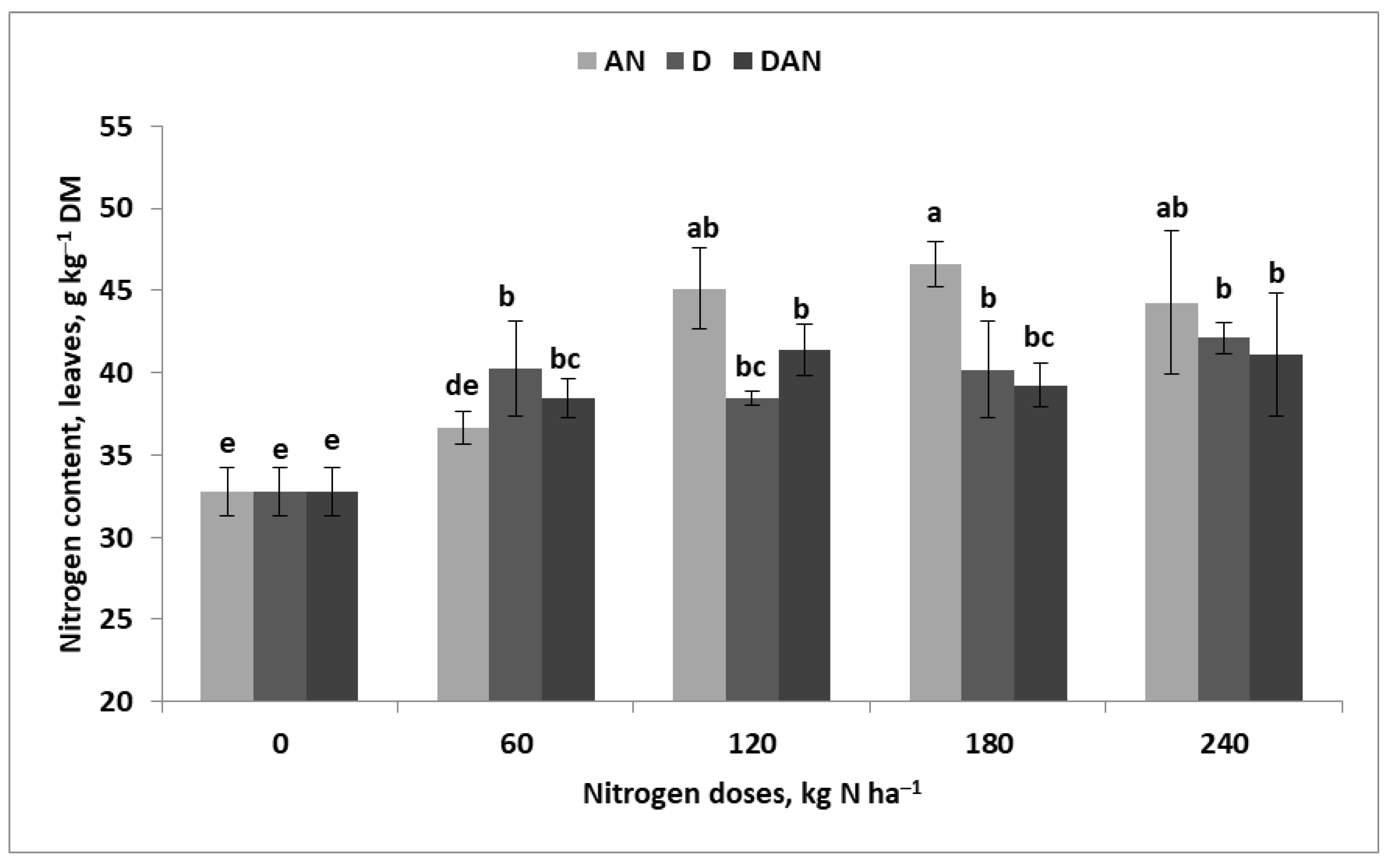
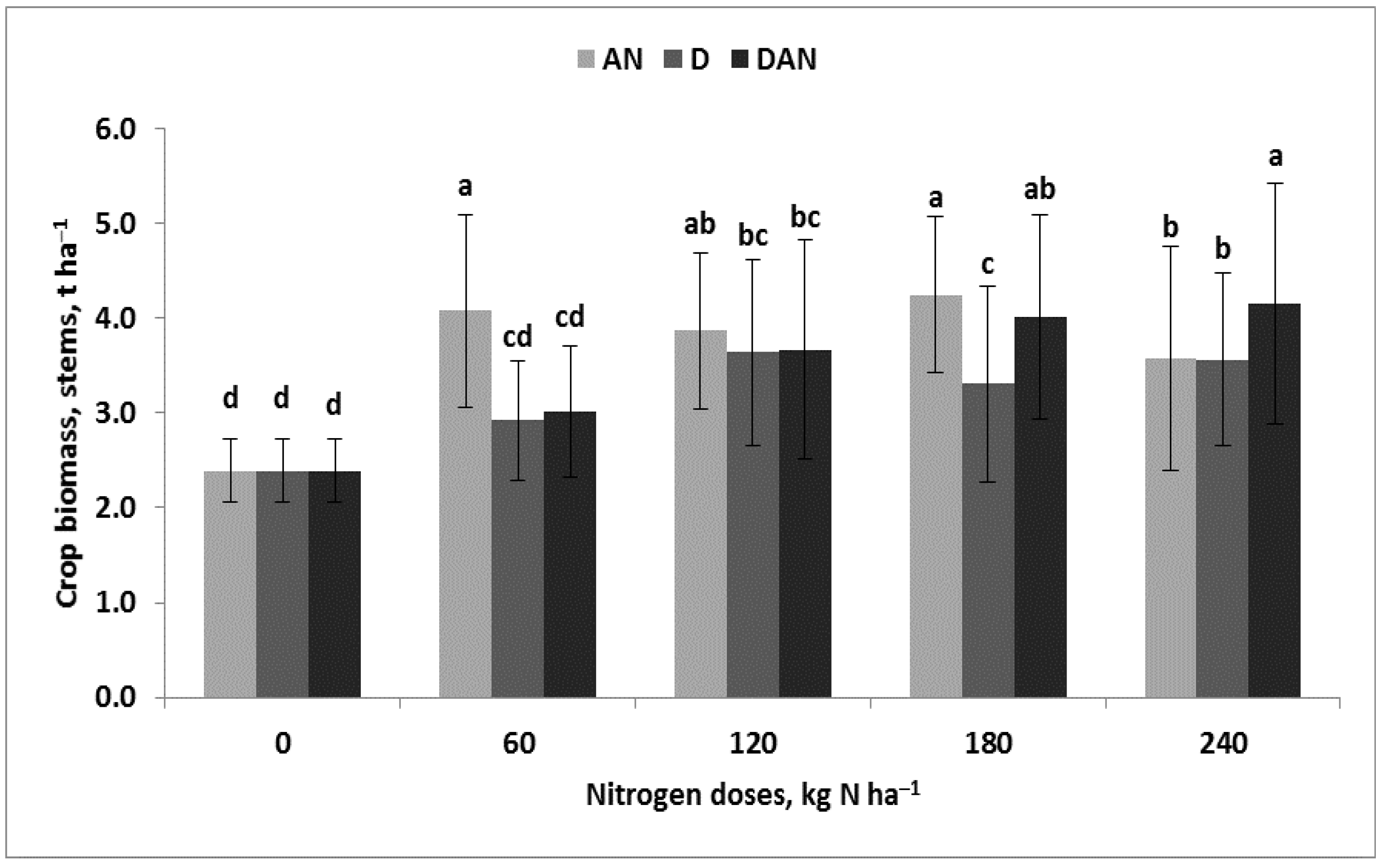

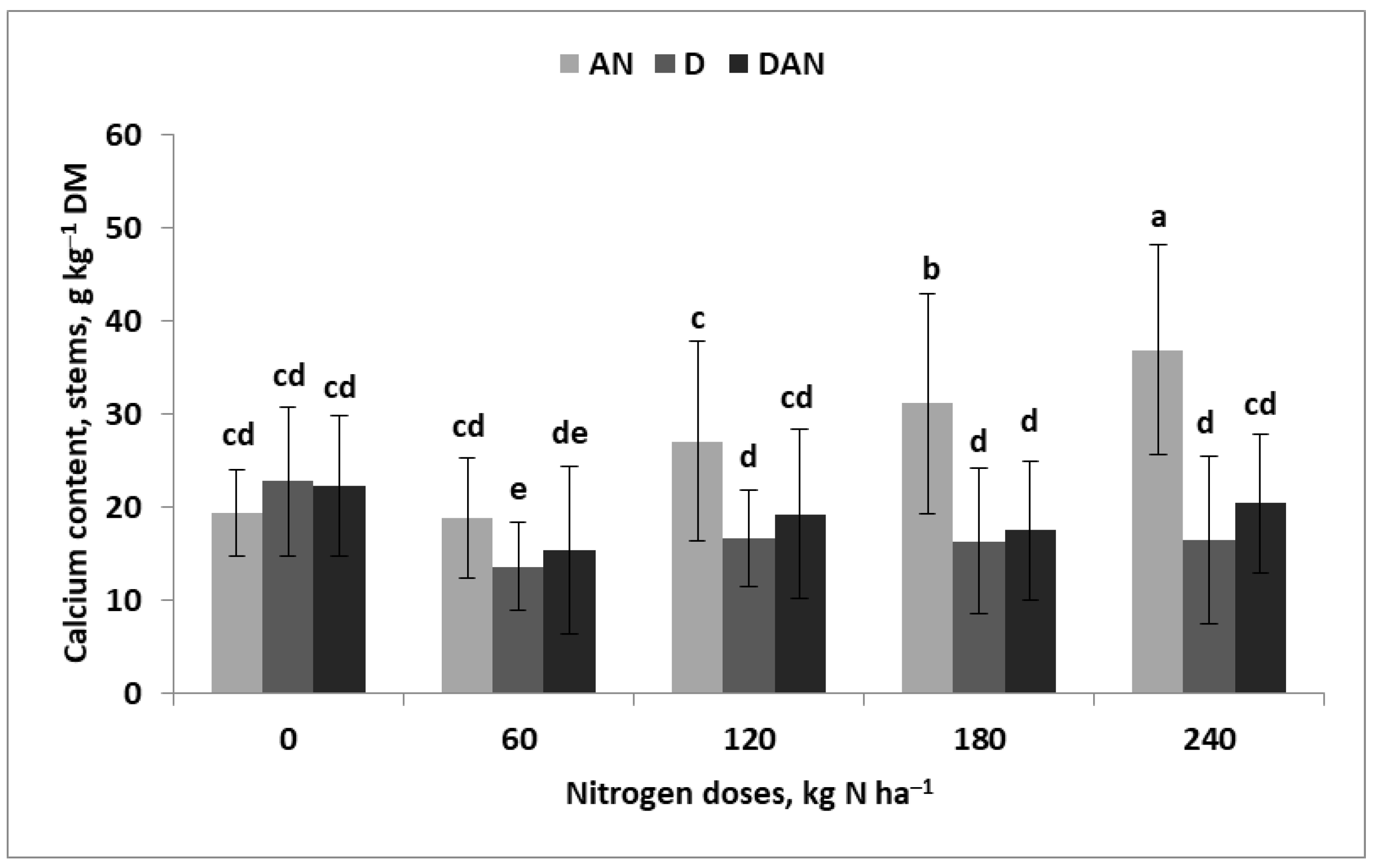


| Year/Soil Layer, cm | Growing Seasons and Nutrients | |||||||||||
|---|---|---|---|---|---|---|---|---|---|---|---|---|
| 2015/2016 | 2016/2017 | 2017/2018 | ||||||||||
| Macronutrients | P | K | Ca 4 | Mg | P | K | Ca | Mg | P | K | Ca | Mg |
| 0–30 | 80 ± 29 2 H 3 | 155 ± 38 H | 390 ± 61 L 4 | 62 ± 6 H 3 | 88 ± 72 H | 105 ± 37 M | 430 ± 156 VL | 72 ± 12 M | 63 ± 24 M | 157 ± 12 H | 490 ± 156 L | 61 ± 8 M |
| 30–60 | 30 ± 12 VL | 96 ± 27 M | 275 ± 100 VL | 59 ± 11 H | 53 ± 44 L | 80 ± 22 M | 369 ± 86 VL | 65 ± 16 M | 20 ± 5 VL | 99 ± 28 L | 342 ± 169 VL | 84 ± 32 H |
| 60–90 | 17 ± 6 VL | 71 ± 16 M | 309 ± 299 VL | 73 ± 20 H | 53 ± 34 L | 70 ± 23 L | 298 ± 44 VL | 62 ± 12 H | 14 ± 2 VL | 69 ± 19 L | 553 ± 265 L | 117 ± 18 VH |
| Micronutrients | Fe | Mn | Zn | Cu | Fe | Mn | Zn | Cu | Fe | Mn | Zn | Cu |
| 0–30 | 238 ± 8 M 5 | 51 ± 12 M | 2.4 ± 0.5 M | 1.3 ± 0.2 L | 187 ± 28 M | 39 ± 12 M | 2.8 ± 1.1 M | 0.9 ± 0.6 L | 212 ± 59 M | 45 ± 9 M | 2.7 ± 0.3 M | 2.71 ± 1.9 M |
| 30–60 | 142 ± 29 M | 40 ± 10 M | 1.8 ± 0.2 L | 1.2 ± 0.2 L | 151 ± 48 M | 25 ± 16 L | 1.3 ± 0.7 L | 0.7 ± 0.5 L | 127 ± 17 M | 24 ± 14 L | 1.4 ± 0.4 L | 2.4 ± 0.8 M |
| 60–90 | 118 ± 8 M | 23 ± 7 L | 1.4 ± 0.3 L | 0.8 ± 0.2 L | 146 ± 46 M | 19 ± 9 L | 1.1 ± 0.7 L | 0.5 ± 0.3 L | 105 ± 12 < | 13 ± 3 L | 1.1 ± 0.2 L | 2.3 ± 0.9 M |
| Growing Season | Consecutive Months During the WOSR Growing Season | ||||||||||||
|---|---|---|---|---|---|---|---|---|---|---|---|---|---|
| VIII | IX | X | XI | XII | I | II | III | IV | V | VI | VII | Average | |
| Temperature, °C | |||||||||||||
| 2015/2016 | 21.1 | 14.1 | 8.5 | 7.1 | 6.7 | −0.9 | 3.7 | 4.3 | 8.8 | 15.7 | 18.5 | 19.0 | 10.6 |
| 2016/2017 | 17.8 | 16.8 | 8.6 | 9.3 | 3.0 | −0.7 | 1.6 | 6.7 | 7.4 | 14 | 17.2 | 17.7 | 10.0 |
| 2017/2018 | 18.2 | 13.6 | 11.2 | 5.8 | 3.4 | 2.7 | −1.8 | 0.5 | 12.3 | 16.6 | 18.5 | 20.0 | 10.1 |
| 1981–2010 | 23.0 | 13.9 | 9.4 | 4.4 | 1.1 | 0.2 | 0.9 | 4.0 | 8.6 | 13.6 | 16.2 | 18.6 | 9.5 |
| Precipitation, mm | |||||||||||||
| 2015/2016 | 26.5 | 40.9 | 61.0 | 57.4 | 45.7 | 38.6 | 56.6 | 33.3 | 33.5 | 17.4 | 73.9 | 78.5 | 563.3 |
| 2016/2017 | 69.0 | 0.0 | 54.0 | 49.0 | 57.8 | 66.7 | 58.0 | 51.2 | 47.0 | 56.7 | 106.0 | 236.6 | 852.0 |
| 2017/2018 | 92.7 | 62.0 | 120.5 | 113.3 | 32.6 | 76.7 | 5.7 | 23.1 | 61.0 | 26.8 | 19.3 | 68.3 | 683.5 |
| 1981–2010 | 80.6 | 62.0 | 52.2 | 53.0 | 50.1 | 57.5 | 30.2 | 35.6 | 36.9 | 65.6 | 57.9 | 93.8 | 675.3 |
| Macronutrients | N | P | K | Ca | Mg | Source |
|---|---|---|---|---|---|---|
| g kg−1 DM | 55 | 5.8 | 25 | 11 | 1.2 | [42] |
| 40–47 | 3.5–5.0 | 30–44 | 10–22 | 1.5–2.5 | [43] | |
| 48–55 | 6–8 | 36–40 | 14–17 | 3.5–4.5 | [44] | |
| Micronutrients | Fe | Mn | Zn | Cu | ||
| mg kg−1 DM | 125 | 41 | 37.5 | 4.5 | [42] | |
| 60–80 | 30–140 | 30–38 | 4.9–6.2 | [43] | ||
| 35–45 | 25–35 | 20–40 | 4.0–5.5 | [44] |
| Macronutrients | N | P | K | Ca | Mg | Source |
|---|---|---|---|---|---|---|
| g kg−1 DM | 40–55 | 3.5–7.0 | 28–50 | 10–20 | 2.5–4.0 | [45] |
| 33–64 | 3.4–6.9 | 29–51 | 14–30 | 2.1–6.2 | [46] | |
| 37–44 | 5–6 | 27–43 | 27–33 | 1.7–3.0 | [47] | |
| Micronutrients | Fe | Mn | Zn | Cu | ||
| mg kg−1 DM | - | 30–100 | 25–70 | 5–12 | [45] | |
| - | 30–140 | 30–38 | 4.9–6.2 | [46] | ||
| 129–214 | 25–48 | 28–51 | 4.3–7.4 | [47] |
| Factor | Level of Factor | N | P | K | Mg | Ca | Fe | Mn | Zn | Cu | SY | BR |
|---|---|---|---|---|---|---|---|---|---|---|---|---|
| g kg−1 | mg kg−1 | t ha−1 | ||||||||||
| Year/season | 2015/16 | 42.2 b | 2.6 c | 26.7 c | 1.9 b | 15.9 b | 244.2 a | 36.5 b | 26.2 b | 5.2 b | 3.2 a | 0.9 b |
| (Y) | 2016/17 | 42.7 b | 4.5 a | 32.7 b | 2.3 a | 14.3 a | 132.1 c | 26.2 c | 26.0 b | 5.3 b | 3.3 a | 1.3 a |
| 2017/18 | 46.7 a | 3.2 b | 37.0 a | 1.5 c | 17.2 b | 189.2 b | 41.1 a | 62.0 a | 6.0 a | 2.0 b | 0.7 b | |
| F-value, p | 34.0 *** | 271 *** | 110 *** | 237 *** | 11.2 *** | 222 * | 66.3 *** | 744 *** | 17.1 *** | 402 ** | 150 *** | |
| Fertilization | AN | 44.2 | 3.4 | 33.5 a | 1.9 | 18.2 a | 182.5 b | 37.2 a | 38.5 a | 5.6 a | 2.7 b | 1.1 a |
| system | D | 43.3 | 3.5 | 31.3 b | 1.9 | 14.1 b | 199.5 a | 33.7 b | 39.7 a | 5.6 a | 2.8 b | 0.9 b |
| (FS) | DAN | 44.1 | 3.5 | 31.5 b | 1.9 | 15.0 b | 183.4 b | 33.0 c | 36.0 b | 5.3 b | 3.0 a | 1.0 ab |
| F-value, p | 1.2 ns | 0.5 ns | 6.3 ** | 1.4 ns | 25.2 *** | 6.5 ** | 5.7 ** | 6.1 ** | 3.7 * | 19.9 *** | 4.5 * | |
| Nitrogen | 0 | 41.3 c | 3.6 | 31.5 | 1.8 b | 17.5 ab | 153.7 b | 34.7 b | 35.7 b | 5.5 | 1.6 d | 0.9 a |
| doses | 60 | 43.1 bc | 3.4 | 32.0 | 1.9 ab | 18.1 a | 200.6 a | 36.3 b | 40.8 a | 5.5 | 2.8 c | 1.0 a |
| (N) | 120 | 44.7 ab | 3.5 | 33.1 | 1.9 ab | 15.5 bc | 188.7 a | 32.1 b | 36.7 b | 5.5 | 3.1 a | 1.0 a |
| 180 | 44.8 ab | 3.3 | 32.2 | 1.9 a | 14.2 c | 202.4 a | 33.5 ab | 39.1 ab | 5.4 | 3.3 a | 0.9 a | |
| 240 | 45.4 a | 3.5 | 31.9 | 1.9 a | 13.7 c | 196.8 a | 36.4 ab | 38.1 ab | 5.5 | 3.2 a | 1.0 a | |
| F-value, p | 9.6 *** | 2.1 ns | 0.9 ns | 3.0 * | 12.5 *** | 17.2 *** | 2.4 ns | 4.1 ** | 0.1 ns | 221 *** | 2.7 * | |
| F-values for interactions | ||||||||||||
| Y × FS | ns | ns | ns | ** | *** | *** | *** | ** | * | * | ns | |
| Y × N | ns | ns | ns | ns | *** | *** | *** | *** | ns | *** | ** | |
| FS × N | ns | ns | ns | * | * | ns | *** | * | ns | * | ns | |
| Y × FS × N | ns | ns | ns | *** | *** | *** | ** | ** | ns | *** | ns | |
| Mean | 43.8 | 3.5 | 32.1 | 1.9 | 15.8 | 188.5 | 34.6 | 38.1 | 5.5 | 1.0 | 2.8 | |
| Standard deviation | 2.9 | 0.8 | 4.7 | 0.4 | 4.1 | 56.6 | 10.4 | 17.9 | 0.5 | 0.3 | 0.9 | |
| Coefficient of variation,% | 6.7 | 23.6 | 14.7 | 20.5 | 25.7 | 30.0 | 29.9 | 47.0 | 9.3 | 28.3 | 33.0 | |
| Variables | Rosettes | Leaves—Flowering | STEMS—FLOWERING | ||||||
|---|---|---|---|---|---|---|---|---|---|
| PC1 | PC2 | PC3 | PC1 | PC2 | PC3 | PC1 | PC2 | PC3 | |
| N | 0.59 | 0.32 | −0.40 | 0.08 | 0.08 | 0.85 | 0.49 | −0.72 | 0.36 |
| P | −0.54 | 0.77 | −0.10 | 0.78 | −0.49 | 0.15 | 0.90 | 0.29 | 0.08 |
| K | 0.47 | 0.81 | −0.10 | −0.64 | 0.56 | 0.35 | −0.20 | −0.83 | 0.42 |
| Mg | −0.90 | 0.17 | −0.03 | −0.91 | −0.06 | 0.03 | −0.93 | −0.17 | −0.11 |
| Ca | 0.26 | 0.04 | 0.80 | 0.37 | 0.72 | 0.36 | 0.53 | −0.71 | −0.14 |
| Fe | 0.37 | −0.82 | −0.17 | 0.50 | −0.72 | −0.16 | −0.88 | −0.29 | −0.18 |
| Mn | 0.74 | −0.17 | −0.29 | 0.57 | −0.39 | 0.47 | −0.92 | −0.23 | −0.13 |
| Zn | 0.87 | 0.36 | 0.04 | 0.63 | 0.40 | 0.59 | 0.81 | −0.42 | 0.29 |
| Cu | 0.70 | 0.39 | −0.25 | 0.63 | −0.66 | 0.14 | 0.67 | 0.30 | 0.49 |
| SY | −0.60 | −0.30 | −0.60 | −0.53 | −0.67 | 0.37 | −0.50 | 0.24 | 0.77 |
| BR | −0.82 | 0.41 | −0.07 | — | — | — | — | — | — |
| BL | — | — | — | −0.58 | −0.61 | 0.30 | −0.51 | 0.32 | 0.67 |
| BS | — | — | — | −0.95 | −0.17 | 0.17 | −0.88 | −0.10 | 0.35 |
| Factor | Level of Factor | N | P | K | Mg | Ca | Fe | Mn | Zn | Cu | BL | BS | BC |
|---|---|---|---|---|---|---|---|---|---|---|---|---|---|
| g kg−1 | mg kg−1 | t ha−1 | |||||||||||
| Year/season | 2015/16 | 38.6 b | 3.1 a | 29.0 c | 1.9 b | 16.1 b | 169.9 a | 58.4 a | 31.4 b | 5.5 a | 2.0 a | 2.8 b | 4.9 b |
| (Y) | 2016/17 | 38.2 | 2.3 b | 43.2 a | 3.0 a | 16.7 b | 108.7 b | 35.6 c | 21.9 c | 3.5 c | 2.0 a | 5.0 a | 7.0 a |
| 2017/18 | 41.6 a | 2.8 a | 39.6 b | 1.7 c | 32.7 a | 113.6 b | 52.5 b | 50.4 a | 4.2 b | 1.3 b | 2.4 c | 3.7 c | |
| F, p-values | 12.3 *** | 82.9 *** | 176 *** | 359 *** | 464 *** | 242 *** | 242 *** | 505 *** | 138 *** | 118 *** | 434 *** | 331 *** | |
| Fertilization | AN | 41.1 a | 2.6 b | 37.8 | 2.3 a | 25.1 a | 123.1 b | 49.1 | 35.6 a | 4.4 | 1.9 a | 3.6 a | 5.5 a |
| system | D | 38.7 b | 2.9 a | 37.6 | 2.1 b | 19.8 b | 137.6 a | 49.3 | 35.3 a | 4.4 | 1.7 b | 3.2 b | 4.8 b |
| (FS) | DAN | 38.6 b | 2.6 b | 36.5 | 2.1 b | 20.5 b | 131.5 a | 48.1 | 32.9 b | 4.3 | 1.8 a | 3.4 b | 5.2 a |
| F, p-values | 7.0 ** | 7.3 ** | 1.7 ns | 7.0 *** | 47.8 *** | 11.1 *** | 0.7 ns | 5.4 ** | 0.9 ns | 10.9 *** | 12.8 *** | 15.3 *** | |
| Nitrogen | 0 | 32.7 c | 2.7 | 33.9 c | 1.9 b | 21.5 ab | 133.7 | 45.7 b | 30.9 | 4.2 b | 1.3 d | 2.4 c | 3.7 c |
| doses | 60 | 38.4 b | 2.7 | 36.3 bc | 2.2 a | 21.4 b | 125.7 | 40.6 d | 31.5 | 4.4 b | 1.7 c | 3.3 b | 5.0 b |
| (ND) | 120 | 41.6 a | 2.8 | 37.4 ab | 2.3 a | 20.6 b | 134.9 | 52.1 ab | 33.1 | 4.3 b | 1.9 ab | 3.7 a | 5.7 a |
| 180 | 42.0 a | 2.8 | 39.5 a | 2.3 a | 22.0 ab | 131.2 | 50.3 b | 38.5 | 4.5 a | 2.1 a | 3.9 a | 6.0 a | |
| 240 | 42.5 a | 2.6 | 39.4 a | 2.3 a | 23.6 a | 128.2 | 55.3 a | 38.8 | 4.5 a | 1.9 b | 3.8 a | 5.7 a | |
| F, p-values | 35.6 *** | 1.1 ns | 10.7 *** | 11.8 *** | 3.8 ** | 1.9 ns | 34.3 *** | 21.2 *** | 0.2 ns | 44.0 ** | 49.4 *** | 60.5 *** | |
| F-values for interactions | |||||||||||||
| Y × FS | ns | ns | ns | ns | ns | *** | *** | *** | * | *** | *** | *** | |
| Y × N | *** | ns | * | ns | *** | *** | *** | *** | *** | *** | *** | *** | |
| FS × N | *** | ns | ns | * | *** | ** | * | *** | ns | *** | *** | *** | |
| Y × FS × N | * | ns | ns | ns | *** | *** | *** | *** | ns | *** | *** | *** | |
| Mean | 39.5 | 2.7 | 37.3 | 2.2 | 21.8 | 130.8 | 48.8 | 34.6 | 4.4 | 1.8 | 3.4 | 5.2 | |
| Standard deviation | 5.3 | 0.4 | 6.8 | 0.6 | 9.1 | 34.2 | 14.5 | 14.0 | 0.9 | 0.6 | 1.4 | 1.9 | |
| Coefficient of variation,% | 13.3 | 14.0 | 18.3 | 28.7 | 41.5 | 26.2 | 29.6 | 40.5 | 21.0 | 32.9 | 41.7 | 36.3 | |
| Factor | Level of Factor | N | P | K | Mg | Ca | Fe | Mn | Zn | Cu |
|---|---|---|---|---|---|---|---|---|---|---|
| g kg−1 | mg kg−1 | |||||||||
| Year/season | 2015/16 | 25.5 b | 3.3 a | 37.0 b | 2.1 b | 12.5 b | 56.8 c | 27.6 b | 34.3 b | 5.2 a |
| (Y) | 2016/17 | 25.4 b | 2.3 b | 43.3 a | 3.0 a | 13.6 b | 216.0 a | 132.4 a | 22.3 c | 3.5 c |
| 2017/18 | 32.1 a | 3.2 a | 43.9 a | 2.0 b | 36.7 a | 72.2 b | 31.9 b | 46.5 a | 4.4 b | |
| F. p-values | 71.2 *** | 176 *** | 59.3 *** | 195 *** | 279 *** | 1355 *** | 940 *** | 195 *** | 87.8 *** | |
| Fertilization | AN | 27.9 | 2.9 b | 41.4 | 2.4 a | 26.7 a | 115.5 | 60.1 | 34.6 | 4.5 |
| system | D | 27.9 | 3.1 a | 41.4 | 2.3 ab | 17.2 b | 118.1 | 65.9 | 35.0 | 4.3 |
| (FS) | DAN | 27.2 | 2.9 b | 41.4 | 2.3 b | 18.9 b | 111.4 | 66.0 | 33.6 | 4.3 |
| F. p-values | 0.8 ns | 5.8 ** | 0.1 ns | 3.9 * | 37.9 *** | 2.0 ns | 3.0 ns | 0.7 ns | 0.9 ns | |
| Nitrogen | 0 | 23.5 c | 3.0 | 36.4 d | 2.3 | 21.5 a | 121.2 a | 66.0 ab | 28.6 c | 4.0 b |
| doses | 60 | 26.4 b | 3.0 | 39.9 c | 2.4 | 15.9 b | 108.0 b | 54.3 c | 32.6 bc | 4.3 ab |
| (N) | 120 | 28.9 a | 3.0 | 42.2 bc | 2.3 | 21.0 a | 118.4 a | 64.3 ab | 36.6 ab | 4.5 a |
| 180 | 29.7 a | 3.0 | 43.5 ab | 2.3 | 21.7 a | 107.3 b | 62.3 b | 36.2 ab | 4.4 ab | |
| 240 | 29.8 a | 2.8 | 45.1 a | 2.4 | 24.6 a | 120.1 a | 73.0 a | 37.9 a | 4.5 a | |
| F. p-values | 21.3 *** | 1.3 ns | 23.4 *** | 0.8 ns | 8.7 *** | 4.9 ** | 7.4*** | 11.3 *** | 2.9 * | |
| F-values for interactions | ||||||||||
| Y × FS | ns | ns | ns | ns | * | * | * | ns | ns | |
| Y × N | ** | ns | ns | ns | ns | *** | *** | ns | *** | |
| FS × N | ** | * | ns | * | *** | *** | ** | ** | ns | |
| Y × FS × N | ns | ns | ns | ns | * | *** | *** | *** | * | |
| Mean | 27.7 | 3.0 | 41.4 | 2.3 | 20.9 | 115.0 | 64.0 | 34.4 | 4.4 | |
| Standard deviation | 4.6 | 0.5 | 4.8 | 0.5 | 13.4 | 75.5 | 51.3 | 11.6 | 0.9 | |
| Coefficient of variation,% | 16.8 | 17.0 | 11.6 | 20.2 | 63.9 | 65.7 | 80.2 | 33.8 | 20.6 | |
Disclaimer/Publisher’s Note: The statements, opinions and data contained in all publications are solely those of the individual author(s) and contributor(s) and not of MDPI and/or the editor(s). MDPI and/or the editor(s) disclaim responsibility for any injury to people or property resulting from any ideas, methods, instructions or products referred to in the content. |
© 2025 by the authors. Licensee MDPI, Basel, Switzerland. This article is an open access article distributed under the terms and conditions of the Creative Commons Attribution (CC BY) license (https://creativecommons.org/licenses/by/4.0/).
Share and Cite
Łukowiak, R.; Szczepaniak, W.; Młodecki, D. Impact of Digestate-Derived Nitrogen on Nutrient Content Dynamics in Winter Oilseed Rape Before Flowering. Agronomy 2025, 15, 1241. https://doi.org/10.3390/agronomy15051241
Łukowiak R, Szczepaniak W, Młodecki D. Impact of Digestate-Derived Nitrogen on Nutrient Content Dynamics in Winter Oilseed Rape Before Flowering. Agronomy. 2025; 15(5):1241. https://doi.org/10.3390/agronomy15051241
Chicago/Turabian StyleŁukowiak, Remigiusz, Witold Szczepaniak, and Dominik Młodecki. 2025. "Impact of Digestate-Derived Nitrogen on Nutrient Content Dynamics in Winter Oilseed Rape Before Flowering" Agronomy 15, no. 5: 1241. https://doi.org/10.3390/agronomy15051241
APA StyleŁukowiak, R., Szczepaniak, W., & Młodecki, D. (2025). Impact of Digestate-Derived Nitrogen on Nutrient Content Dynamics in Winter Oilseed Rape Before Flowering. Agronomy, 15(5), 1241. https://doi.org/10.3390/agronomy15051241





